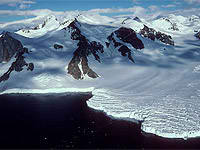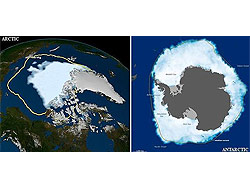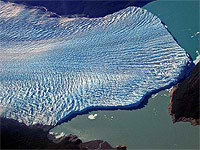El grupo de expertos exploró los témpanos del fiordo en busca de pruebas de que las aguas de latitudes más cálidas, o subtropicales, se estuvieran filtrando en esta región remota y frígida. Y las hallaron hasta la base de los glaciares que penetran el océano como lengüetas de hielo desde la capa helada maciza de Groenlandia, añadió la agencia
Además de otros hallazgos similares en el oeste de Groenlandia, el descubrimiento podría ayudar a explicar por qué los glaciares han empezado a derretirse más rápidamente en la década pasada, un fenómeno que ha causado alarma porque contribuye a elevar los niveles del mar.
"Las medidas de por sí no son suficientes para concluir que el derretimiento del glaciar se debe en gran parte al agua subtropical. Pero creo que el panorama empieza a aclararse", dijo el director de la investigación, Fiamma Straneo.
Asimismo, hallaron aguas subtropicales con una temperatura de unos 4 grados centígrados en las profundidades del fiordo. "Hemos medido las aguas en su fuente y hemos comprobado que sus temperaturas suben, suben, suben de modo que no puede explicarse sin tener en cuenta la influencia humana", dijo Curry.
La investigación pone de manifiesto la compleja interacción entre los océanos y una atmósfera cálida. Los océanos ayudan a contener el calentamiento global absorbiendo casi la mitad del anhídrido carbónico despedido por los seres humanos en la atmósfera, pero el agua también se expande al calentarse y eleva los niveles del mar, lo que genera inundaciones.
Noticia publicada en ADN Mundo (Argentina)
Enlaces a sitios |
| |
Climbing Magazine Climbing Magazine"s Web site contains more than 30 years of rock and ice climbing news, climber profiles, technical information, and gear reviews. You"ll also find message boards, photo galleries, and classifieds
| Cold Regions Bibliography Between 1999 and 2000, this project was carried out under an Interagency Agreement between the Federal Research Division of the Library of Congress and the U.S. Army Cold Regions Research and Engineering Laboratory (CRREL).
|
Descent into the Ice A tem of "glacionauts" ventures into a labyrinth of unexplored anda hazardous glacier caves on France"s Mont Blanc
| Glacier and Permafrost Hazards in Mountains – GAPHAZ Scientific Working Group of the International Association of Cryospheric Sciences (IACS) and the International Permafrost Association (IPA). Department of Geosciences University of Oslo
|
Glacier hazards The experience and data on glacier disasters in Switzerland has been systematically collected in the past two decades, and historical sources were analyzed.
| Glacier Hazards From Space Glacier hazards represent a continuous threat to human lives and infrastructure in mountain regions.
|
Glacier Hazards in Perú The floods, known in Perú as aluviónes, come with little or no warning and are composed of liquid mud that generally transports large rock boulders and blocks of ice.
| Glaciers and Glacier Hazards Glaciers and Glacier Hazards Glaciers and Ice Sheets and Volcanic Eruptions, USGS/Cascades Volcano Observatory, Vancouver, Washington
|
Glaciers online Glaciers online offers photos and summary explanations concerning glaciers from all over the world. The primary goal of our project is to enrich and stimulate the teaching of Earth Science and Physical Geography, in particular glaciology.. Jürg Alean & Mi
| Global Land Ice Measurements from Space GLIMS (Global Land Ice Measurements from Space) is a project designed to monitor the world"s glaciers primarily using data from optical satellite instruments, such as ASTER (Advanced Spaceborne Thermal Emission and reflection Radiometer).
|











 Imagen: British Antarctic Survey (BAS)
Imagen: British Antarctic Survey (BAS)





